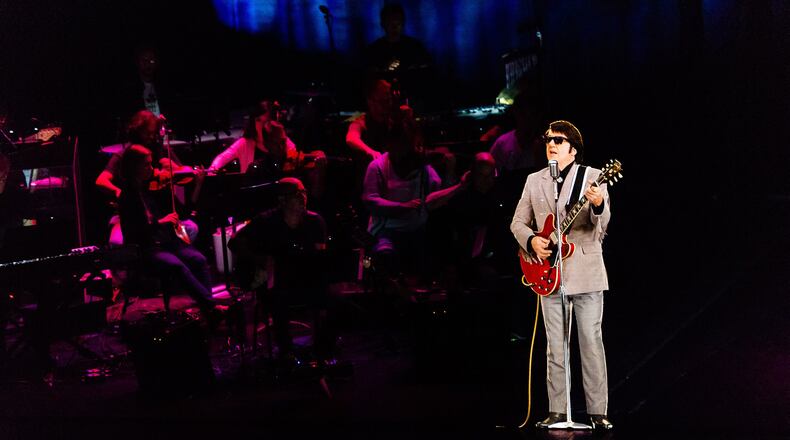Everyone, like Ronald Reagan, Ronnie James Dio and Maria Callas seems to be coming back to life these days.
The relatively new field of digital holograms is creating concerts and other presentations featuring moving, speaking and (up to now, anyway) dead celebrities. And exciting show business people.
“In the live space, there hasn’t been a quote-unquote new form of entertainment in hundreds of years,” said Martin Tudor, CEO of BASE Hologram Productions. “It’s always been your typical concert, play or musical or opera. One of the things that excited us is that there’s something new and fresh here that we can bring to market.”
Those aren’t your daddy’s holograms, however – in the classical sense of 3-D photographic images made with lasers –– at the recently installed exhibit of the 40th president moving and talking at the Reagan Presidential Library or the “Pretty Woman” singer in the traveling show “In Dreams: Roy Orbison in Concert.”
They’re actually more a combination of computer animation and visual tricks that date back to the 19th century; lasers are involved only if the final, composited images are displayed through a laser projector.
“The holograms that you’re seeing, as far as Tupac and Michael Jackson, Ronnie James Dio and Ronald Reagan, actually use a technique called Pepper’s ghost,” said Chad Finnerty, co-owner and VFX supervisor of Marina Del Rey-based Digital Frontier FX, which made the Dio and Reagan holograms. “It’s not really a true, three-dimensional hologram; it’s more of an illusion.”
First demonstrated by English scientist John Henry Pepper in 1862, the Pepper’s ghost technique has been used in such things as teleprompters and the ghosts you see in Disneyland’s Haunted Mansion ride.
“The way it works is, there’s an image bounced onto a see-through sheet of plastic that’s called a foil,” Finnerty said. “That’s how the image appears to be standing by itself onstage. You can see right through it, you can put lighting and props behind it so it appears that this person is part of the environment. So it’s an illusion; it really is a magic trick.”
One that, these days, requires loads of tech-enabled artistry to pull off convincingly. The Reagan holograms involved a year of work by 15 digital artists to computer-sculpt, render and animate a persuasive Reagan head that could then be composited atop video of a body actor who mimicked the president’s physical moves. That, after they watched hours of reference videos to understand how Reagan looked when he spoke.
Over at BASE Hologram, which created the Orbison and currently touring Callas shows and is working on one depicting Amy Winehouse, the process is even more elaborate. Because the star’s image will move around and interact on a stage with otherwise live musicians, the body doubles rehearse for weeks (12 in the Callas actor’s case) before they’re recorded. They’ll also wear prosthetics to resemble their subjects more, though CGI work still goes into the painstaking endeavor.
Epson laser projectors throw the hologram image onstage at a super-bright 25,000 lumens. And although he couldn’t go into detail about the proprietary technology that makes the hologram visible, BASE’s Tudor confirmed that it was not bouncing off clear plastic sheeting.
“All I can say is that a good magician never gives away his tricks,” said Tudor, whose hologram division of live show producer BASE Entertainment is headquartered near Century City. BASE Hologram contracts out the sound separation for their shows (the holograms “sing” the artist’s actual vocal tracks, which sometimes have to be isolated from old monaural recordings) and digital animation to leading edge Hollywood specialty companies (Tudor said they’ve worked with Digital Frontier). BASE then combines the elements into the hologram in-house.
“It’s one of our favorite challenges to recreate a human likeness,” Finnerty said. “It’s probably one of the most difficult tasks that we can do, too. We do everything from animate creatures to zombies for ‘The Walking Dead.’ We do all sorts of things, but it’s a lot easier to make a zombie than it is to make a political figure stand on stage or a rock legend give a concert. It’s got to look absolutely real, and everyone knows what a human looks like – especially when the human has been seen many times by many people.”
It can also be a somewhat ethically fraught endeavor. The Orbison estate filed a lawsuit against a different company, Hologram USA, last year. But while some Winehouse fans are wary of next year’s hologram show, her father Mitch gave BASE his blessing and recently expressed qualified support for the project to the British Guardian newspaper.
Tudor, who comes from a talent management background, is scrupulous about working with his shows’ subjects’ estates and/or survivors in a cooperative manner, and never making a hologram do something the artist would not have done. He also made it clear that the shows are promoted as hologram performances, not actual resurrections or anything.
“I have a deep respect for how artists are perceived, and what they want and don’t want to happen,” Tudor said. “The only way I would do this is with the guidance of the estate, because I want it to be authentic. Look, I could have made the (notoriously static performer) Roy Orbison do backflips across the stage if I wanted to, or I could have Maria Callas sing an Eminem rap song. But would they ever do that? No.”
Tudor said the Orbison show met box office expectations and that the Callas one has already sold out two upcoming Paris dates. He admitted that the holograms have a slightly translucent, ethereal quality, but added that there’s anecdotal evidence that audiences’ eyes quickly adjust to that.
“The response in Europe was extraordinary,” he said regarding the Orbison show. “The audiences really took to it, and I’m told that after 10 minutes, though you psychologically know that that’s not a real person up there, after awhile your brain just begins to accept it.
“Audiences sing along with Roy Orbison, they dance in the aisles, they applaud after the songs,” Tudor said. “They’re right there. They’re in it.”
About the Author
Keep Reading
The Latest
Featured



